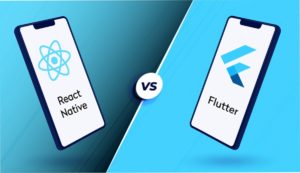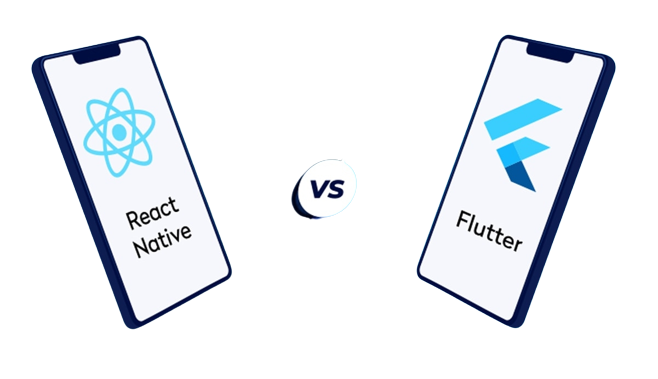As the demand for mobile apps continues to rise, developers are increasingly turning to cross-platform frameworks to create apps that can run on multiple platforms. Two of the most popular frameworks for building cross-platform apps are React Native and Flutter.
As the demand for mobile apps continues to rise, developers are increasingly turning to cross-platform frameworks to create apps that can run on multiple platforms. Two of the most popular frameworks for building cross-platform apps are React Native and Flutter. Both of these frameworks have their strengths and weaknesses and choosing the right one can be a challenging decision for developers. In this post, we’ll compare React Native and Flutter and examine the pros and cons of each framework.
What is React Native?
React Native is an open-source mobile application framework created by Facebook in 2015. It allows developers to create mobile apps using JavaScript and React, which are both widely used web technologies. React Native uses a single codebase, which means that developers can write code once and deploy it to multiple platforms, such as iOS and Android. This makes it a popular choice for companies that want to develop cross-platform apps.
What is Flutter?
Flutter is an open-source mobile application development framework created by Google in 2017. It uses the Dart programming language and offers a wide range of widgets and tools to create high-performance, visually appealing mobile apps. Like React Native, Flutter allows developers to build cross-platform apps with a single codebase, which can save time and resources.

Pros and Cons of React Native
-
Pros
- Easy to Learn: React Native uses JavaScript and React, which are widely used web technologies, making it easy for web developers to learn and use.
- Large Community: React Native has a large and active community of developers, which means there are plenty of resources and tools available for developers to use.
- Code Reusability: React Native allows developers to write code once and deploy it on multiple platforms, which can save time and resources.
- Hot Reloading: React Native offers hot reloading, which means that developers can see the changes they make in real-time without having to rebuild the entire app.
-
Cons
- Performance: React Native can be slower than native development, which can result in slower app performance.
- Limited UI Components: React Native has limited UI components compared to Flutter, which means that developers may need to create custom components or use third-party libraries to achieve the desired UI.
- Unstable Modules: Some modules in React Native may be unstable or not maintained, which can lead to compatibility issues.
Pros and Cons of Flutter
-
Pros
- High Performance: Flutter offers high-performance development, which can result in faster app performance compared to React Native.
- Rich UI Components: Flutter offers a wide range of customizable UI components, which can help developers create visually appealing and intuitive apps without needing to use third-party libraries.
- Hot Reload: Flutter also offers hot reload, which allows developers to see the changes they make in real time without having to rebuild the entire app.
- Strong Documentation: Flutter has strong documentation and tools, which can make it easy for developers to get started and learn how to use the framework.
-
Cons
- Steep Learning Curve: Flutter uses the Dart programming language, which may be unfamiliar to some developers. This may make it more difficult to learn compared to React Native.
- New framework: Additionally, because Flutter is still a relatively new framework, there are fewer resources available online for developers to learn from.
- Larger app size: Another downside of Flutter is that it has a larger app size compared to React Native. Flutter’s built-in widgets and libraries add more weight to the final app size. This can be a drawback for users who have limited storage space on their devices.
Despite these cons, Flutter has some notable advantages. Let’s take a closer look at how Flutter compares to React Native in several key areas.
Comparison of React Native vs. Flutter
-
Performance
Flutter has an advantage in terms of performance. It uses its rendering engine, called Skia, which is highly optimized for mobile devices. This allows Flutter to achieve high frame rates and faster app startup times compared to React Native.
React Native, on the other hand, uses a JavaScript bridge to communicate between the native code and the JavaScript code. While this allows for a more flexible development experience, it can lead to performance issues and slower app startup times.
-
Development speed
Both frameworks allow for fast development times, thanks to the ability to build once and deploy to multiple platforms. However, Flutter’s hot reload feature allows developers to see changes in the app in real-time, making the development process even faster. React Native also has a hot reloading feature, but it is not as fast as Flutters.
-
Community support
React Native has a larger community than Flutter, which means that developers have more resources and support available to them. However, the Flutter community is growing quickly, and Google is actively investing in its development.
-
User interface
Both frameworks allow for the creation of beautiful and engaging user interfaces. However, Flutter’s built-in widgets and libraries provide a more polished and cohesive look and feel. React Native’s user interface is more flexible, but it requires more customization to achieve a consistent look and feel.
-
Learning curve
As mentioned earlier, Flutter’s learning curve is steeper than React Native’s, due to the use of the Dart programming language. However, once developers are comfortable with Dart, they can use it to build both frontend and backend code.
Which cross-platform apps to Choose?
Choosing between React Native and Flutter ultimately comes down to your development needs and goals. React Native is a more mature framework with a larger community and more resources available. It is also a good choice for developers who are familiar with JavaScript and want a more flexible development experience.
On the other hand, Flutter is a newer framework with faster performance and a more polished user interface. It is a good choice for developers who are comfortable with Dart and want to create high-quality, cross-platform apps.
Conclusion of cross-platform apps
Both React Native and Flutter offer developers the ability to build high-quality, cross-platform apps. While React Native has a larger community and more resources available, Flutter has faster performance and a more polished user interface. Ultimately, the choice between these two frameworks depends on your development needs and goals. Regardless of which framework you choose, building cross-platform apps has never been easier, thanks to these powerful tools.
Check out Tanbits on GoodFirms. Our company can assist you in creating a dynamic mobile application that is both user-friendly and highly visible on app stores. Contact us to learn more about our mobile app design and development services.
BACK










